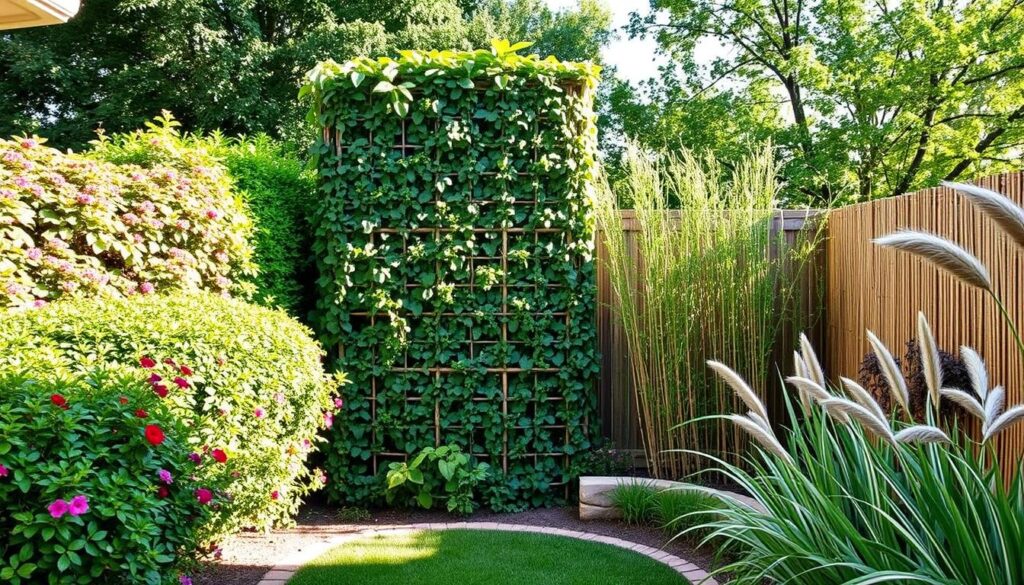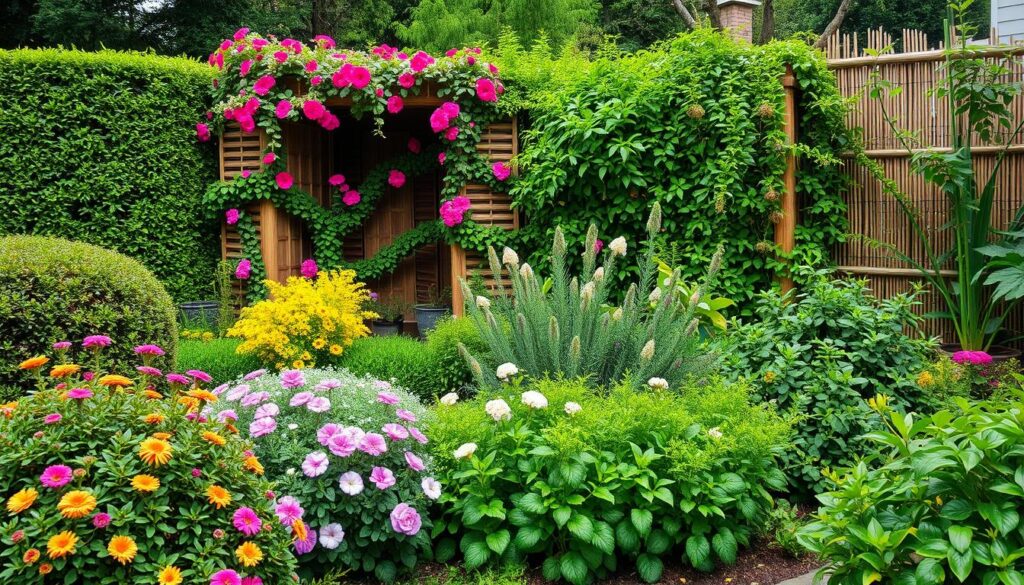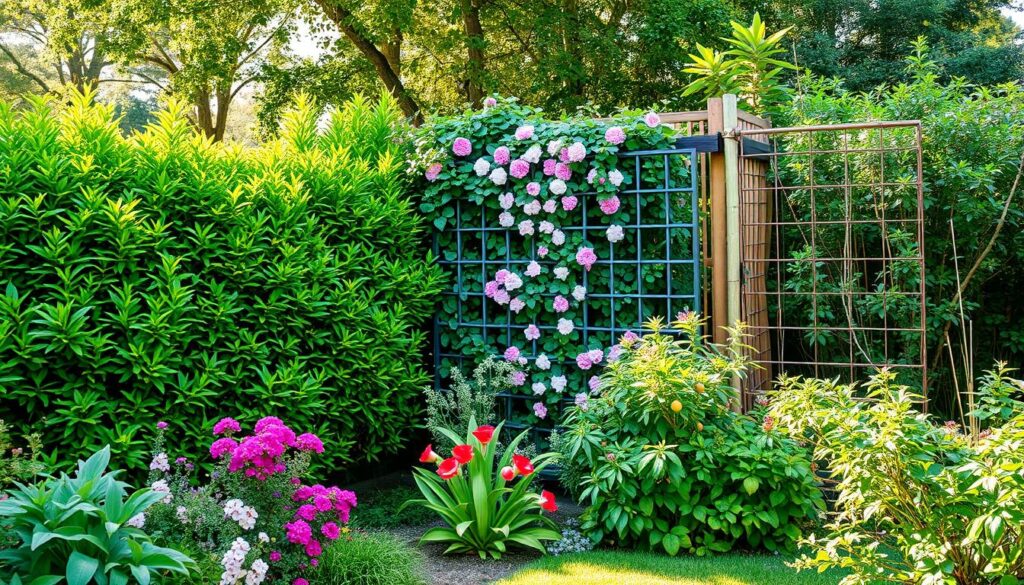Table of Contents
Have you thought about changing your yard’s edge with living fences? These fences use plants, trees, or shrubs. They do more than just mark your space. They also bring many benefits to the environment and look great.
By choosing living fences, you make your yard better and help the planet. You can make your outdoor area look amazing and feel connected to nature. Find out how to make your yard a green oasis that shows off your style and care for the earth!

Key Takeaways
- Living fences provide sustainable garden fencing alternatives to traditional barriers.
- They enhance privacy while promoting biodiversity and supporting local wildlife.
- Using plants creatively allows for a personalized and aesthetically pleasing outdoor space.
- Natural barriers can reduce long-term costs compared to conventional fencing.
- Integrating living fences contributes to the overall health of the environment.
- The right plant choices play a crucial role in the effectiveness of living fences.
What is a Living Fence?
A living fence is a boundary made of dense plants. It’s both useful and beautiful. This idea uses hedges, shrubs, and climbing plants. The definition of living fences goes beyond regular fences. It grows and changes over time.
So, what is a living fence? It’s a green wall that does many things. It blocks wind, cuts down noise, and homes local animals. It makes the area more lively, fitting well with organic yard design.

Benefits of Living Fences
Living fences bring many benefits to homeowners. They are good for the environment and look great. These fences can really change how your outdoor space looks and feels.
Environmental Advantages
Living fences are good for the planet. They clean the air by removing pollutants and making oxygen. They also give homes to birds and insects.
These fences help keep the soil in place. This makes the environment healthier.
Aesthetic Appeal
Living fences make any property look better. They come in many shapes, sizes, and colors. This lets homeowners create beautiful borders that change with the seasons.
From colorful flowers in spring to beautiful leaves in autumn, living fences are more attractive than regular fences. They make outdoor spaces welcoming and full of life.
Cost-Effectiveness Over Time
Living fences might cost more at first than regular fences. But they save money in the long run. They need less upkeep, which means less money spent over time.
Homeowners save money because living fences improve their landscape. This means they don’t have to spend as much on other landscaping. Investing in living fences is a smart choice for your wallet.

Transform Your Yard Boundary with These 5 Living Fence Ideas!
Changing your yard boundary can be a fun journey. There are many living fence ideas to boost privacy and beauty. Think about using natural elements that are both beautiful and useful. Here are five cool living fence ideas to help you change your yard.
Hedges for Privacy and Protection
Dense hedges like arborvitae or boxwood make great boundaries. They keep noise out and make your yard feel calm. Plus, they make your yard look green and welcoming.
Climbing Plants on Trellises
Using climbing plants on trellises adds charm and coverage. Plants like clematis or ivy can quickly turn your yard into a green wall. This gives you privacy and makes your yard look great.
Bamboo as a Natural Barrier
Bamboo fences are a smart choice for a green fence. Bamboo grows fast and is strong. It makes a thick screen and adds a modern, exotic feel to your yard.
Flowering Shrubs for Vibrant Colors
Flowering shrubs add color and attract pollinators. Plants like hydrangeas or hibiscus can line your boundary. They make your yard lively and welcoming.
Edible Plant Fences
Edible plant fences are a smart mix of beauty and usefulness. Plants like berry bushes or herbs not only beautify your yard but also give you fresh food. This is a fun twist on traditional fences.
| Living Fence Idea | Benefits | Best Plants |
|---|---|---|
| Privacy Hedges | Noise reduction, security | Boxwood, Arborvitae |
| Climbing Plants | Vertical coverage, charm | Clematis, Ivy |
| Bamboo Fences | Sustainable, fast-growing | Bamboo |
| Flowering Shrubs | Colorful displays, pollinator-friendly | Hydrangeas, Hibiscus |
| Edible Plant Fences | Fresh produce, beauty | Berry bushes, Herbs |
Choosing the Right Plants for Your Living Fence
Choosing plants for your living fence needs careful thought. It’s important to know your climate considerations and soil type. Each plant has its own needs, so pick ones that fit your environment well.
Consider Climate and Soil Type
Your area’s weather affects which plants will do well. For example, warm places are good for fast-growing hedges like privet or yaupon holly. But, cold areas might do better with hardy plants like lilac or ornamental grasses.
Soil type also matters. Well-drained soils work well for many plants. But, clay soils might limit your choices. Plants native to your area usually need less care and water.
Growth Rate and Maintenance
The speed at which plants grow affects your living fence’s success. Fast-growing vines like climbing plants cover areas quickly. But, slower-growing plants like boxwoods take longer to fill in but create a dense barrier.
Think about how much upkeep you can handle. Some plants need regular pruning, while others are easier to care for. Knowing how much time you can dedicate helps keep your living fence looking good.
| Plant Type | Growth Rate | Soil Preference | Maintenance Level |
|---|---|---|---|
| Clematis | Fast | Moist, Well-drained | Low |
| Boxwood | Slow | Well-drained | Medium |
| Viburnum | Moderate | Moist, Well-drained | Low |
| Privet | Fast | Variety | High |
Designing Your Living Fence
Creating a living fence that’s inviting and effective needs careful planning. Think about the shapes and height you want. A well-designed fence can make your landscape look better and set clear boundaries without losing beauty.
Incorporating Shapes and Heights
Using different plant heights adds excitement to your fence. Taller plants can be the background, while shorter ones add color and texture up front. Mixing shapes, like rounded topiaries or angular shrubs, adds visual interest. Curves can make your fence feel natural, blending with your yard’s other features.
Layering for Depth and Variety
Layering is key in designing living fences. It creates a beautiful mix of greenery and flowers. Stagger the heights of your plants to add depth and make sure each layer is seen.
Choosing a mix of evergreen and seasonal plants makes your garden change with the seasons. Plants with different textures and colors add variety and make your garden look full and lush.
Integrating Living Fences into Your Outdoor Landscape
Adding living fences to your outdoor space can really make your home stand out. These natural barriers not only keep things private but also add beauty. They blend well with your garden and other outdoor features.
Choosing the right plants is key. This way, your living fence will look like it’s part of the whole landscape. It can connect smoothly with patios, walkways, and flower beds.
Enhancing Curb Appeal
Living fences make your yard more interesting. A well-planned living fence can highlight your entrance and guide visitors. It can also make your yard feel welcoming.
Think about adding flowering shrubs or climbing plants. They bring color and texture, making your outdoor space lively all year round.
Complementing Other Landscaping Features
When you add living fences, consider how they work with other outdoor elements. For example, tall hedges with lower flower beds add depth. Climbing plants on trellises encourage exploration.
A well-thought-out design makes your outdoor area more beautiful. It becomes a great place for relaxing and having fun.
Maintaining Your Living Fence
Keeping your living fences healthy is key to a beautiful garden. Regular care boosts their look and growth. Learning how to prune and water them right is crucial for their long life.
Pruning Techniques
Pruning is essential for your living fences. It shapes the plants, encourages new growth, and fights off diseases. Prune during the plant’s dormant season to avoid stressing it out.
Remove any dead or sick parts and keep the shape balanced. This will make your living fence look great.
Fertilization and Irrigation Tips
Good garden care means the right food and water for your plants. Each plant is different, so you need to adjust your care for each one. Check the soil moisture and use organic fertilizers to help them grow strong.
| Plant Type | Pruning Frequency | Fertilization Needs | Irrigation Requirements |
|---|---|---|---|
| Hedges | Twice a year | Moderate | Regular, maintain damp soil |
| Climbing Plants | Annual | Low | Weekly, ensuring good drainage |
| Flowering Shrubs | Once a year | High during blooming season | Moderate, adjust for seasonal changes |
Natural Privacy Barriers vs. Traditional Fences
Homeowners often look at comparing living and traditional fences for yard boundaries. Living fences, made of plants, have big advantages over wood or vinyl. They offer beauty and benefits for the environment that traditional fences can’t match.
Natural barriers blend well with nature. They help local wildlife and increase biodiversity, making them good for the planet. Living fences change with the seasons, adding a unique look that fixed fences can’t. Unlike traditional fences, they need only occasional trimming and care.
| Feature | Natural Privacy Barriers | Traditional Fences |
|---|---|---|
| Privacy Level | Varies with growth | Immediate |
| Visual Appeal | Changes seasonally | Static design |
| Environmental Impact | Supports wildlife | Minimal |
| Maintenance Required | Low (pruning) | High (repairs, painting) |
| Cost Over Time | Lower (long-term growth) | Higher (replacement costs) |
In summary, comparing living and traditional fences shows natural barriers are better. They make a property look great and are good for the environment. For a smart, beautiful, and green fence, living fences are the best choice.
Sustainable Garden Fencing Options
For those who care about the planet, sustainable garden fencing is key. It lets you make your outdoor space beautiful and useful without harming the environment. There are many choices that help you meet your sustainability goals. This way, your garden becomes more than just a place for you. It also helps in the global effort to protect our planet.
Benefits of Eco-Friendly Choices
Choosing sustainable garden fencing has many advantages:
- Reduced Environmental Impact: These materials use less carbon than traditional ones.
- Promotes Biodiversity: Living fences and natural barriers help local wildlife and boost biodiversity.
- Cost-Effective in the Long Run: Even though they might cost more upfront, they save money on upkeep.
Examples of Sustainable Materials
There are many sustainable materials for garden fencing:
- Bamboo: A fast-growing plant that’s strong and versatile. Bamboo fencing adds beauty and is good for the planet.
- Recycled Wood: Wood from recycled materials cuts down on waste and adds character to your garden.
- Composite Materials: Made from recycled plastics and wood fibers, they’re durable and eco-friendly.
- Metal Alternatives: Recycled metals make for lasting and stylish fences.
Impact on Local Wildlife
Living fences greatly affect local wildlife, offering them vital resources. By choosing native plants for your fence, you create habitats for many species. This helps maintain ecological balance.
Creating Habitats
Living fences act as natural sanctuaries for birds, butterflies, and beneficial insects. They provide food, shelter, and nesting areas. Well-designed fences promote connections within the ecosystem, benefiting both individual species and the environment.
How Living Fences Contribute to Biodiversity
Using a variety of native plants boosts biodiversity in your yard. This approach fosters interactions between species and improves local wildlife health. Living fences attract pollinators and other beneficial organisms.
By focusing on biodiversity, you turn your yard into a thriving ecosystem. This is a great way to support local wildlife.
Budgeting for Your Fence Transformation
Turning your yard into a living fence needs careful money planning. Knowing how to budget for living fence options is key for homeowners. The upfront cost might seem high, but looking at long-term costs shows a different story. A living fence can be a wise investment that saves money over time.
Initial Investment vs. Long-Term Savings
When comparing the costs of a living fence, look at both the first payment and future savings. Here’s a simple comparison:
| Expense Type | Initial Cost | Long-Term Savings |
|---|---|---|
| Plants and Materials | $500 – $1,500 | Lower maintenance costs, less frequent replacement |
| Maintenance | $100 – $300 (annual) | Potentially reduced compared to traditional fencing |
| Property Value Increase | N/A | Estimated increase of 5-10% over time |
Living fences need less upkeep, which saves money. They also last longer than regular fences, saving on replacement costs. Knowing this helps homeowners make smart choices for their yards, leading to long-term savings.
Conclusion
Living fences can change your yard in many ways. They offer privacy and security, and they make your yard look better. You can pick from many plants to match your style and the weather in your area.
Living fences also help the environment. They support local wildlife and add to the beauty of your yard. They save money in the long run and can even make your home more valuable.
Choosing living fences is more than just making your yard look good. It’s a step towards a greener future. With the right planning, these fences will make your outdoor space beautiful and useful for years.
FAQ
What are some popular plants for creating a living fence?
For a living fence, consider dense hedges like arborvitae or boxwood. Climbing plants such as clematis and ivy are also good. Flowering shrubs add color, and berry bushes offer beauty and food.
How do living fences compare with traditional fences?
Living fences are more than just pretty. They offer privacy and help the environment. Traditional fences give quick privacy but lack the charm and benefits of living fences. Living fences also support wildlife.
How much maintenance do living fences require?
Living fences need regular pruning and watering. They also need occasional fertilizer. The upkeep depends on the plants you choose, with native plants needing less care.
Can living fences be cost-effective?
Living fences might cost more at first than some fences. But they save money over time because they need less care. They can also increase your property’s value.
What climate considerations should I make when selecting plants for my living fence?
Think about your local weather, soil, and what plants need to grow. Native plants are often better because they need less water and care. They’re great for a green fence.
How can I design an attractive living fence?
To make a living fence look good, mix plant heights and shapes. Use taller plants in the back and shorter ones up front. Curves and unique shapes add interest and fit well with your yard.
What are some eco-friendly materials for garden fencing?
Good eco-friendly options include living plants, bamboo, recycled wood, and composites. These choices are better for the planet and look natural.
How do living fences benefit local wildlife?
Living fences help many animals, like birds and butterflies. By using native plants, you help local wildlife and create a healthy garden ecosystem.
What should I know about the initial costs of installing a living fence?
First, think about the cost of plants and materials for your living fence. Even though it might seem expensive at first, living fences save money in the long run. They also add value to your home.

